Kobza Marek
Plant Pathology and Mycology RG
Researcher

Mgr. Marek Kobza, PhD.
Slovak Academy of Sciences
Institute of Forest Ecology
Plant Pathology & Mycology Research Group
Akademická 2
949 01 Nitra
Phone: +421 37 6943 335
Email: marek.kobza@ife.sk
Research Interests:plant protection, acoustic tomography, fungal diseases of woody plants, biological control, trunk injection
Education:
- PhD. in Plant Protection, Faculty of Agrobiology and Food Resources, Slovak University of Agriculture in Nitra (2006)
- MSc. in Biology and Chemistry, Faculty of Natural Sciences, Constantine the Philosopher University in Nitra (2000)
Academic employment:
- Researcher, Slovak Academy of Sciences, Institute of Forest Ecology, Branch for Woody Plants Biology (since 2006)
- PhD study, Institute of Forest Ecology, Branch for Woody Plants Biology (2002-2005)
Projects:
- VEGA 2/0122/22 – Diversity and pathogenicity of ophiostomatoid fungi in Scots pine stands infested by bark beetles (2022-2025, member of research team)
- VEGA 2/0132/22 – Impact of climate change on the distribution of selected pathogens of Pinus sp. trees (2022-2025, member of research team)
- MVTS Ochrana mestských stromov (2021-2025, member of research team)
- VEGA 2/0077/18 – Identification, genetic variability a pathogenicity of economically important needle cast species on pines (2018-2021, member of research team)
- VEGA 2/002/18 – Ash dieback: the causal agents and disease control strategy (2018-2021, member of research team)
- VEGA 2/0143/15 – Štúdium vplyvu faktorov prostredia na výskyt a rozšírenie rakoviny kôry gaštana jedlého (Castanea sativa) na Slovensku a možností ochrany proti tejto chorobe
- COST FP1406 – PINESTRENGTH – „Pine pitch canker“- stratégie pre manažment Gibberella circinata v skleníkoch a lesoch
- VEGA 2/0071/14 – Druhová diverzita a biologické vlastnosti parazitických húb podieľajúcich sa na poškodení a usychaní drevín
- VEGA 2/0069/14 – Biológia, rozšírenie a diagnostika škodlivého činiteľa Dothistroma septosporum (Mycosphaerella pini), D. pini a iných škodlivých činiteľov asimilačných orgánov borovíc.
- VEGA: 2/0149/10 – Štúdium morfologických, genetických a biologických charakteristík vybraných rodov húb z triedy Coelomycetes, ich patogenita a rozšírenie v rôznych ekologických podmienkach
- VEGA 2/0214/10 – Štúdium fenotypickej a genetickej variability a rôznej citlivosti k hubovým chorobám pri gaštane jedlom (Castanea sativa Mill.)
Internships:
- 2004, Short term research stay at Hungarian Academy of Sciences, Budapest, Hungary
2024 |
|
Ondrušková, E; Kobza, M; Jánošíková, Z; McDougal, R; Adamčíková, K Which Cyclaneusma minus morphotypes are responsible for needle cast of Pinus sp. in Slovakia? Journal Article Journal of Plant Diseases and Protection, 131 , pp. 1665–1672, 2024, ISSN: 1861-3829. @article{Ondrušková2024, title = {Which Cyclaneusma minus morphotypes are responsible for needle cast of Pinus sp. in Slovakia?}, author = {E. Ondrušková and M. Kobza and Z. Jánošíková and R. McDougal and K. Adamčíková}, doi = {https://doi.org/10.1007/s41348-024-00924-y}, issn = {1861-3829}, year = {2024}, date = {2024-05-10}, journal = {Journal of Plant Diseases and Protection}, volume = {131}, pages = {1665–1672}, abstract = {Cyclaneusma needle cast (CNC) is a needle disease which caused deterioration of vitality and reduction in the growth of pines. The disease is caused by the ascomycetous fungus Cyclaneusma minus, which has two well-described morphotypes; C. minus simile and C. minus verum. The distribution and host range of C. minus simile and verum was determined from needle samples and isolates collected throughout Slovakia from 2014 to 2020. Samples from 111 localities, 11 pine host species and 245 trees collected in different types of planting were analysed. It was found, that both morphotypes are present, but C. minus verum is predominantly responsible for CNC in urban and forest plantings in Slovakia. C. minus verum was positively detected in more than 88% of collected samples, whereas C. minus simile was only in four samples from three localities. Morphotype-specific primers were sufficiently sensitive even for new pine-host species. The host range of C. minus simile and C. minus verum was enriched worldwide. C. minus verum was observed in nine host species, whereas C. minus simile was identified only in one. Cyclaneusma niveum was also recorded and its presence was confirmed through DNA sequencing.}, keywords = {}, pubstate = {published}, tppubtype = {article} } Cyclaneusma needle cast (CNC) is a needle disease which caused deterioration of vitality and reduction in the growth of pines. The disease is caused by the ascomycetous fungus Cyclaneusma minus, which has two well-described morphotypes; C. minus simile and C. minus verum. The distribution and host range of C. minus simile and verum was determined from needle samples and isolates collected throughout Slovakia from 2014 to 2020. Samples from 111 localities, 11 pine host species and 245 trees collected in different types of planting were analysed. It was found, that both morphotypes are present, but C. minus verum is predominantly responsible for CNC in urban and forest plantings in Slovakia. C. minus verum was positively detected in more than 88% of collected samples, whereas C. minus simile was only in four samples from three localities. Morphotype-specific primers were sufficiently sensitive even for new pine-host species. The host range of C. minus simile and C. minus verum was enriched worldwide. C. minus verum was observed in nine host species, whereas C. minus simile was identified only in one. Cyclaneusma niveum was also recorded and its presence was confirmed through DNA sequencing. | |
Jánošíková, Z; Kobza, M; Ondrušková, E; Ostrovský, R; Pažitný, J; Adamčíková, K Virulence of Dothistroma septosporum and D. pini on Pinus nigra and P. mugo under conditions of natural infection Journal Article European Journal of Plant Pathology, 168 (2), pp. 775-785, 2024. @article{Jánošíková2024, title = {Virulence of Dothistroma septosporum and D. pini on Pinus nigra and P. mugo under conditions of natural infection}, author = {Z. Jánošíková and M. Kobza and E. Ondrušková and R. Ostrovský and J. Pažitný and K. Adamčíková}, url = {http://ife.sk/wp-content/uploads/2020/09/Fig_edited.jpghttp://ife.sk/wp-content/uploads/2020/09/final-1-2.jpg}, doi = {https://doi.org/10.1007/s10658-023-02799-5}, year = {2024}, date = {2024-04-04}, journal = {European Journal of Plant Pathology}, volume = {168}, number = {2}, pages = {775-785}, abstract = {Dothistroma needle blight (DNB) is a severe needle disease of pines worldwide, caused by two closely related species, Dothistroma septosporum and D. pini. The two fungal species are similar not only in their morphological characteristics, but also cause very similar symptoms in their hosts, and have a similar ecology. The aim of this study was to compare the virulence of the two Dothistroma species in natural infection experiments on 2-year-old seedlings of two DNB susceptible pine species, Pinus nigra and P. mugo, in two seedling stands for each pathogen species. The virulence of the pathogens and presence of symptoms (symptomatic needles, red bands and acervuli) were assessed after 2 years of exposure to inoculum. The incidence of seedlings with DNB symptoms was 65% and 76% for P. nigra and P. mugo, respectively. No difference was found between D. septosporum and D. pini in any of the three DNB symptoms evaluated on seedlings of P. mugo. However, symptoms of disease differed between the two Dothistroma species on P. nigra. Variables, which reflect the intensity of disease development, the number of red bands and acervuli per needle, showed a difference in virulence between D. septosporum and D. pini, but only in the case of the host species P. nigra. The results suggest that the virulence of the two Dothistroma species could be affected by host pine species and that there are differences in susceptibility of individual pine species to D. septosporum and D. pini. Further factors could affect the virulence of these pathogens, including isolate origin, climatic or environmental factors.}, keywords = {}, pubstate = {published}, tppubtype = {article} } Dothistroma needle blight (DNB) is a severe needle disease of pines worldwide, caused by two closely related species, Dothistroma septosporum and D. pini. The two fungal species are similar not only in their morphological characteristics, but also cause very similar symptoms in their hosts, and have a similar ecology. The aim of this study was to compare the virulence of the two Dothistroma species in natural infection experiments on 2-year-old seedlings of two DNB susceptible pine species, Pinus nigra and P. mugo, in two seedling stands for each pathogen species. The virulence of the pathogens and presence of symptoms (symptomatic needles, red bands and acervuli) were assessed after 2 years of exposure to inoculum. The incidence of seedlings with DNB symptoms was 65% and 76% for P. nigra and P. mugo, respectively. No difference was found between D. septosporum and D. pini in any of the three DNB symptoms evaluated on seedlings of P. mugo. However, symptoms of disease differed between the two Dothistroma species on P. nigra. Variables, which reflect the intensity of disease development, the number of red bands and acervuli per needle, showed a difference in virulence between D. septosporum and D. pini, but only in the case of the host species P. nigra. The results suggest that the virulence of the two Dothistroma species could be affected by host pine species and that there are differences in susceptibility of individual pine species to D. septosporum and D. pini. Further factors could affect the virulence of these pathogens, including isolate origin, climatic or environmental factors. | |
2023 |
|
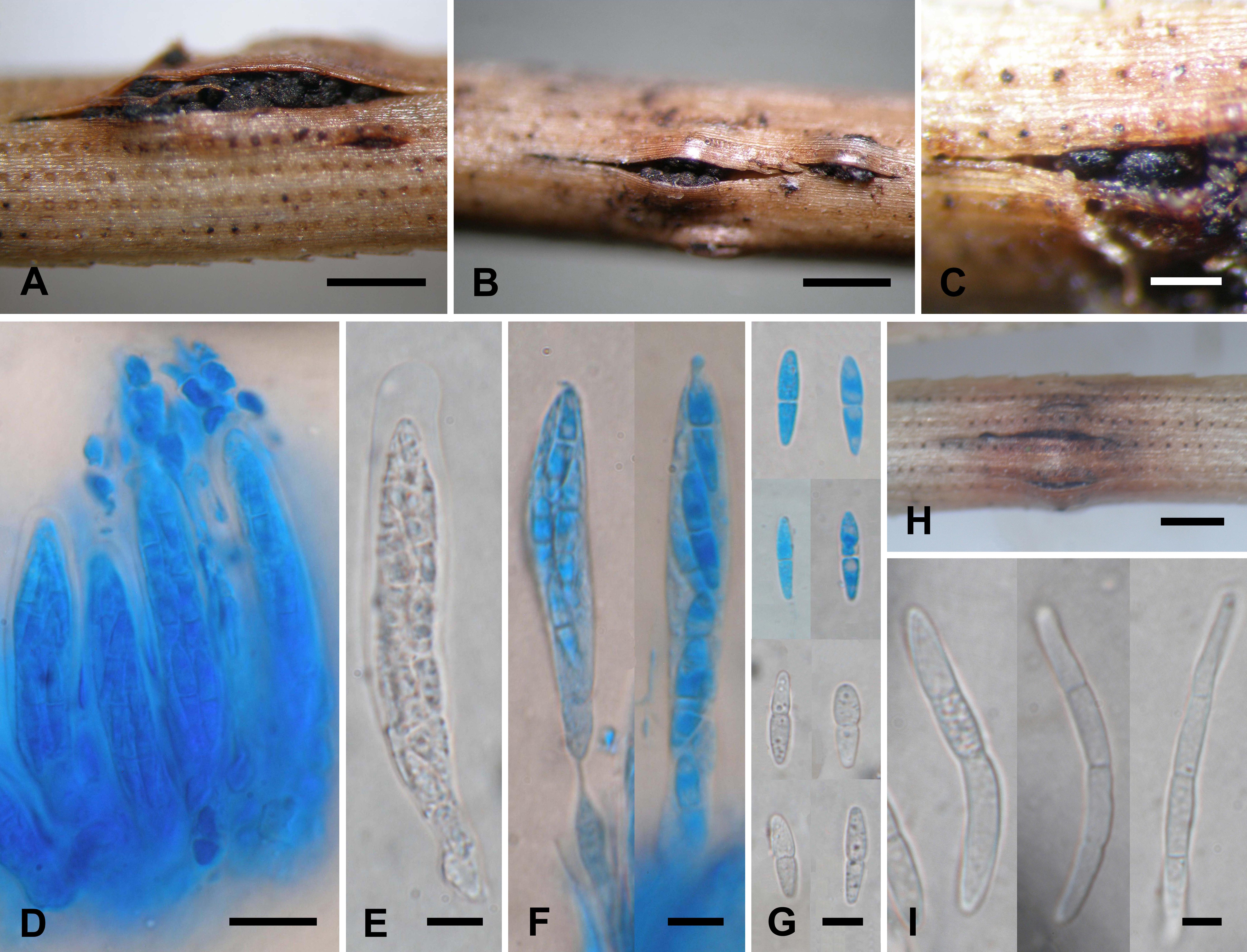 | Adamčíková, K; Pastirčáková, K; Jánošíková, Z; Ostrovský, R; Pastirčák, M; Pažitný, J; Kobza, M; Adamčík, S; Kádasi-Horáková, M; Ondrušková, E New regional records of Dothistroma needle blight pathogens from Slovakia: distribution, hosts and pathogens characterization Journal Article Annals of Forest Research, 66 (1), pp. 99-111, 2023, ISSN: 1844-8135. @article{Adamčíková2023, title = {New regional records of Dothistroma needle blight pathogens from Slovakia: distribution, hosts and pathogens characterization}, author = {K. Adamčíková and K. Pastirčáková and Z. Jánošíková and R. Ostrovský and M. Pastirčák and J. Pažitný and M. Kobza and S. Adamčík and M. Kádasi-Horáková and E. Ondrušková}, doi = {https://doi.org/10.15287/afr.2023.2427}, issn = {1844-8135}, year = {2023}, date = {2023-07-25}, journal = {Annals of Forest Research}, volume = {66}, number = {1}, pages = {99-111}, abstract = {Dothistroma needle blight is one of the most severe needle diseases of pines caused by two closely related species, Dothistroma septosporum and D. pini. The further spread and distribution of this disease was investigated in Slovakia as well as new hosts and stand types were identified at regional level. Dothistroma septosporum was recorded in a natural stand at higher altitude on Pinus cembra in the High Tatras and the P. uncinata records are new host reports for Slovakia for this pathogen. Moreover, for D. pini, P. cembra as a new host at the country level was recorded and P. armandii was identified as new host species worldwide. Mating types for all collected samples and ITS haplotypes for D. pini isolates were determined. For D. pini, five localities with the presence of both mating types and three ITS haplotypes (Dp_HAP.1, Dp_HAP.2 and Dp_HAP.4) were reported. Samples where both mating types of the pathogens were identified, were selected for the microscopic examination of fruiting bodies aimed to detect sexual reproductive organs. In all inspected needle samples of D. pini, only conidiomata with typical hyaline cylindrical conidia were identified. The sexual state of D. septosporum was recorded in one sample of P. nigra needles.}, keywords = {}, pubstate = {published}, tppubtype = {article} } Dothistroma needle blight is one of the most severe needle diseases of pines caused by two closely related species, Dothistroma septosporum and D. pini. The further spread and distribution of this disease was investigated in Slovakia as well as new hosts and stand types were identified at regional level. Dothistroma septosporum was recorded in a natural stand at higher altitude on Pinus cembra in the High Tatras and the P. uncinata records are new host reports for Slovakia for this pathogen. Moreover, for D. pini, P. cembra as a new host at the country level was recorded and P. armandii was identified as new host species worldwide. Mating types for all collected samples and ITS haplotypes for D. pini isolates were determined. For D. pini, five localities with the presence of both mating types and three ITS haplotypes (Dp_HAP.1, Dp_HAP.2 and Dp_HAP.4) were reported. Samples where both mating types of the pathogens were identified, were selected for the microscopic examination of fruiting bodies aimed to detect sexual reproductive organs. In all inspected needle samples of D. pini, only conidiomata with typical hyaline cylindrical conidia were identified. The sexual state of D. septosporum was recorded in one sample of P. nigra needles. |
 | Ondrušková, E; Adamčík, S; Kobza, M; Jánošíková, Z; Ostrovský, R; Pastirčáková, K; Caboň, M; Adamčíková, K Checking the balance between pathogenic and mutualistic pine needle fungi of the genus Lophodermium in forested and urban areas of Slovakia Journal Article Scandinavian Journal of Forest Research, 38 (1-2), pp. 39-48, 2023, ISSN: 1651-1891. @article{Ondrušková2023, title = {Checking the balance between pathogenic and mutualistic pine needle fungi of the genus Lophodermium in forested and urban areas of Slovakia}, author = {E. Ondrušková and S. Adamčík and M. Kobza and Z. Jánošíková and R. Ostrovský and K. Pastirčáková and M. Caboň and K. Adamčíková }, doi = { DOI: 10.1080/02827581.2023.2191004}, issn = {1651-1891}, year = {2023}, date = {2023-03-27}, journal = {Scandinavian Journal of Forest Research}, volume = {38}, number = {1-2}, pages = {39-48}, abstract = {Lophodermium species are well known to be among dominant endophytic fungi colonising pine needles. Occurrence of two species with different life strategies on different Pinus trees across Slovakia was detected by PCR using species specific primers. In general, commensalistic species L. pinastri was more frequent than parasitic L. seditiosum. There were no significant differences observed between urban and natural environments, but natural environments have more frequent colonisation by L. pinastri and less frequent were trees negatively tested to Lophodermium colonisation. Among the most frequently sampled trees were non-native P. nigra and native P. sylvestris. Significant difference in Lophodermium incidence was detected between these two species in natural environment, with increased frequency of L. pinastri on native Scots pine. In addition to one clade of L. pinastri, culture based species identification confirmed presence of L. corconticum and an undescribed clade of L. seditiosum that is not sensitive to used PCR primers for the species detection.}, keywords = {}, pubstate = {published}, tppubtype = {article} } Lophodermium species are well known to be among dominant endophytic fungi colonising pine needles. Occurrence of two species with different life strategies on different Pinus trees across Slovakia was detected by PCR using species specific primers. In general, commensalistic species L. pinastri was more frequent than parasitic L. seditiosum. There were no significant differences observed between urban and natural environments, but natural environments have more frequent colonisation by L. pinastri and less frequent were trees negatively tested to Lophodermium colonisation. Among the most frequently sampled trees were non-native P. nigra and native P. sylvestris. Significant difference in Lophodermium incidence was detected between these two species in natural environment, with increased frequency of L. pinastri on native Scots pine. In addition to one clade of L. pinastri, culture based species identification confirmed presence of L. corconticum and an undescribed clade of L. seditiosum that is not sensitive to used PCR primers for the species detection. |
2022 |
|
 | Barta, M; Pastirčáková, K; Ostrovský, R; Kobza, M; Kádasi-Horáková, M Culturable endophytic fungi in Fraxinus excelsior and their interactions with Hymenoscyphus fraxineus Journal Article Forests, 13 (7), pp. 1-23, Article no. 1098, 2022, ISSN: 1999-4907. @article{Barta2022b, title = {Culturable endophytic fungi in \textit{Fraxinus excelsior} and their interactions with \textit{Hymenoscyphus fraxineus}}, author = {M. Barta and K. Pastirčáková and R. Ostrovský and M. Kobza and M. Kádasi-Horáková}, doi = {10.3390/f13071098}, issn = {1999-4907}, year = {2022}, date = {2022-07-13}, journal = {Forests}, volume = {13}, number = {7}, pages = {1-23, Article no. 1098}, abstract = {The species diversity of culturable endophytic fungi was studied in the leaves and twigs of symptomatic and asymptomatic Fraxinus excelsior trees. Endophytic mycobiota was dominated by Ascomycota species, with Pleosporales (44.17%) and Diaporthales (23.79%) endophytes being the most frequently observed in the tree samples. The number of endophytic isolates and species richness varied depending on the sampling date (May and October) and tissue location. Of the 54 species identified based on ITS sequences, 14 were classified as dominant. The most frequently isolated species were Diaporthe eres, followed by Alternaria alternata, Dothiorella gregaria, and Fraxinicola fraxini. The inhibitory effect of 41 species (75 isolates) of endophytes on the radial growth of a Hymenoscyphus fraxineus isolate was studied under in vitro conditions (dual cultures). The radial growth of H. fraxineus was the most inhibited by four endophytic fungi from twigs (Fusarium lateritium, Didymella aliena, Didymella macrostoma, and Dothiorella gregaria). The inhibitory effect of the four isolates was also studied under in planta conditions. The isolates artificially inoculated into the trunks of ash trees reduced the length of necroses formed by H. fraxineus co-inoculated in the same trunks. This effect depended on the isolate, and the inhibition was most prominent only on trunks inoculated with F. lateritium and D. aliena. Although the total length of necrotic lesions formed by the H. fraxineus infection was shorter in the ash trunks co-inoculated with the endophytes, the difference was not significant.}, keywords = {}, pubstate = {published}, tppubtype = {article} } The species diversity of culturable endophytic fungi was studied in the leaves and twigs of symptomatic and asymptomatic Fraxinus excelsior trees. Endophytic mycobiota was dominated by Ascomycota species, with Pleosporales (44.17%) and Diaporthales (23.79%) endophytes being the most frequently observed in the tree samples. The number of endophytic isolates and species richness varied depending on the sampling date (May and October) and tissue location. Of the 54 species identified based on ITS sequences, 14 were classified as dominant. The most frequently isolated species were Diaporthe eres, followed by Alternaria alternata, Dothiorella gregaria, and Fraxinicola fraxini. The inhibitory effect of 41 species (75 isolates) of endophytes on the radial growth of a Hymenoscyphus fraxineus isolate was studied under in vitro conditions (dual cultures). The radial growth of H. fraxineus was the most inhibited by four endophytic fungi from twigs (Fusarium lateritium, Didymella aliena, Didymella macrostoma, and Dothiorella gregaria). The inhibitory effect of the four isolates was also studied under in planta conditions. The isolates artificially inoculated into the trunks of ash trees reduced the length of necroses formed by H. fraxineus co-inoculated in the same trunks. This effect depended on the isolate, and the inhibition was most prominent only on trunks inoculated with F. lateritium and D. aliena. Although the total length of necrotic lesions formed by the H. fraxineus infection was shorter in the ash trunks co-inoculated with the endophytes, the difference was not significant. |
 | Kobza, M; Ostrovský, R; Adamčíková, K; Pastirčáková, K Stability of trees infected by wood decay fungi estimated by acoustic tomography: a field survey Journal Article Trees Structure and Function, 36 (1), pp. 103-112, 2022, ISSN: 1432-2285. @article{Kobza2022, title = {Stability of trees infected by wood decay fungi estimated by acoustic tomography: a field survey}, author = {M. Kobza and R. Ostrovský and K. Adamčíková and K. Pastirčáková}, url = {https://doi.org/10.1007/s00468-021-02185-w}, doi = {10.1007/s00468-021-02185-w}, issn = {1432-2285}, year = {2022}, date = {2022-02-08}, journal = {Trees Structure and Function}, volume = {36}, number = {1}, pages = {103-112}, abstract = {In this survey, we assessed the relationships between the presence of visible fruiting bodies and measurements of both wood damage and tree safety factor (SF), the final aim being the determination of whether a tree showing wood decay signs should be felled or not. In general, trees affected by wood-decaying fungi cannot be considered risky prior to determining the impact of the fungi on their structural integrity. Trees of nine genera from 13 localities of Slovakia were included in this survey. In total, nineteen species of fungi were found causing wood decay on 74 individual host trees. Acoustic tomography was done using a Fakopp 3D tomograph, and SF was calculated by ArborSonic 3D software. The most commonly occurring taxon, Fomes fomentarius (L.) Fr., was found on six tree genera. The highest degree of damaged area on trunks was caused by fungi in the genera Fomes, Ganoderma, and Perenniporia (over 70%), while the lowest damage was caused by genera Spongipellis, Cerrena, and Auricularia (up to 30%). The lowest values of SF were measured on trees of the genus Acer infected by Fomes fomentarius; Prunus infected by Phellinus pomaceus (Pers.) Maire; and Fagus infected by Ganoderma pfeifferi Bres. Computation of the SF of individual trees plays a vital part in the stability evaluation of trees affected by wood decay fungi.}, keywords = {}, pubstate = {published}, tppubtype = {article} } In this survey, we assessed the relationships between the presence of visible fruiting bodies and measurements of both wood damage and tree safety factor (SF), the final aim being the determination of whether a tree showing wood decay signs should be felled or not. In general, trees affected by wood-decaying fungi cannot be considered risky prior to determining the impact of the fungi on their structural integrity. Trees of nine genera from 13 localities of Slovakia were included in this survey. In total, nineteen species of fungi were found causing wood decay on 74 individual host trees. Acoustic tomography was done using a Fakopp 3D tomograph, and SF was calculated by ArborSonic 3D software. The most commonly occurring taxon, Fomes fomentarius (L.) Fr., was found on six tree genera. The highest degree of damaged area on trunks was caused by fungi in the genera Fomes, Ganoderma, and Perenniporia (over 70%), while the lowest damage was caused by genera Spongipellis, Cerrena, and Auricularia (up to 30%). The lowest values of SF were measured on trees of the genus Acer infected by Fomes fomentarius; Prunus infected by Phellinus pomaceus (Pers.) Maire; and Fagus infected by Ganoderma pfeifferi Bres. Computation of the SF of individual trees plays a vital part in the stability evaluation of trees affected by wood decay fungi. |
2021 |
|
 | Adamčíková, K; Jánošíková, Z; Adamčík, S; Ostrovský, R; Pastirčáková, K; Kobza, M; Ondrušková, E Host range, genetic variability, and mating types of Lecanosticta acicola in Slovakia Journal Article Scandinavian Journal of Forest Research, 36 (5), pp. 325-332, 2021, ISSN: 0282-7581. @article{Adamčíková2021b, title = {Host range, genetic variability, and mating types of \textit{Lecanosticta acicola} in Slovakia}, author = {K. Adamčíková and Z. Jánošíková and S. Adamčík and R. Ostrovský and K. Pastirčáková and M. Kobza and E. Ondrušková}, url = {https://doi.org/10.1080/02827581.2021.1941236}, doi = {10.1080/02827581.2021.1941236}, issn = {0282-7581}, year = {2021}, date = {2021-07-16}, journal = {Scandinavian Journal of Forest Research}, volume = {36}, number = {5}, pages = {325-332}, abstract = {In recent years, there has been an apparent Europe-wide emerging presence of brown spot needle blight, a disease of pine species caused by the fungus Lecanosticta acicola. In this study, we report the first well-documented occurrences of the pathogen in Slovakia, identified molecularly using species-specific primers and based on sequencing of the ITS region and TEF1 gene. Among the material collected from 84 locations within the country, L. acicola was present in 17 samples from 13 different locations, mainly distributed in urban environments. Four pine species were identified as hosts, among which, Pinus nigra and P. mugo were found to be the most frequently infected. Analysis of the mating type genes of 24 isolates obtained from two localities revealed the presence of a single mating type in Slovakia. All analyzed ITS sequences of the Slovak isolates were found to be uniform. However, although analysis of the TEF1 gene indicated that all Slovak isolates could be grouped into a single lineage, we detected nucleotide polymorphisms suggestive of a certain degree of genetic diversification within central European populations of the fungus.}, keywords = {}, pubstate = {published}, tppubtype = {article} } In recent years, there has been an apparent Europe-wide emerging presence of brown spot needle blight, a disease of pine species caused by the fungus Lecanosticta acicola. In this study, we report the first well-documented occurrences of the pathogen in Slovakia, identified molecularly using species-specific primers and based on sequencing of the ITS region and TEF1 gene. Among the material collected from 84 locations within the country, L. acicola was present in 17 samples from 13 different locations, mainly distributed in urban environments. Four pine species were identified as hosts, among which, Pinus nigra and P. mugo were found to be the most frequently infected. Analysis of the mating type genes of 24 isolates obtained from two localities revealed the presence of a single mating type in Slovakia. All analyzed ITS sequences of the Slovak isolates were found to be uniform. However, although analysis of the TEF1 gene indicated that all Slovak isolates could be grouped into a single lineage, we detected nucleotide polymorphisms suggestive of a certain degree of genetic diversification within central European populations of the fungus. |
2020 |
|
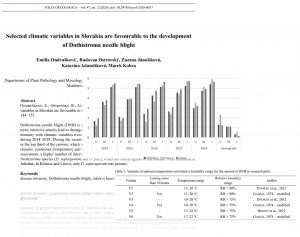 | Ondrušková, Emília; Ostrovský, Radovan; Jánošíková, Zuzana; Adamčíková, Katarína; Kobza, Marek Selected climatic variables in Slovakia are favourable to the development of Dothistroma needle blight Journal Article Folia Oecologica, 47 (2), pp. 144-152, 2020. @article{Ondrušková2020b, title = {Selected climatic variables in Slovakia are favourable to the development of Dothistroma needle blight}, author = {Emília Ondrušková and Radovan Ostrovský and Zuzana Jánošíková and Katarína Adamčíková and Marek Kobza}, url = {http://ife.sk/wp-content/uploads/2020/09/foecol-2020-0008.pdf}, doi = {10.2478/foecol-2020-0017}, year = {2020}, date = {2020-11-24}, journal = {Folia Oecologica}, volume = {47}, number = {2}, pages = {144-152}, abstract = {Dothistroma needle blight (DNB) is a disease of pine needles. It causes significant defoliation of affected trees; intensive attacks lead to damages of the whole stand. The relationship of trends in disease severity and intensity with climatic variables were studied in three Austrian pine plantations (Jahodná, Kálnica, Litava) during 2014–2018. During the monitoring period, the greatest variability in disease severity was observed in the top third of the crowns, which showed the highest correlation with the variants of the most important climatic conditions (temperature and relative humidity) tested. For the spread of DNB, based on statistical assessment, a higher number of intervals of environmentally favourable climatic conditions is crucial. Both Dothistroma species (D. septosporum and D. pini), which are causal agents of the disease, were identified in Jahodná. In Kálnica and Litava, only D. septosporum was present.}, keywords = {}, pubstate = {published}, tppubtype = {article} } Dothistroma needle blight (DNB) is a disease of pine needles. It causes significant defoliation of affected trees; intensive attacks lead to damages of the whole stand. The relationship of trends in disease severity and intensity with climatic variables were studied in three Austrian pine plantations (Jahodná, Kálnica, Litava) during 2014–2018. During the monitoring period, the greatest variability in disease severity was observed in the top third of the crowns, which showed the highest correlation with the variants of the most important climatic conditions (temperature and relative humidity) tested. For the spread of DNB, based on statistical assessment, a higher number of intervals of environmentally favourable climatic conditions is crucial. Both Dothistroma species (D. septosporum and D. pini), which are causal agents of the disease, were identified in Jahodná. In Kálnica and Litava, only D. septosporum was present. |
2019 |
|
 | K. Adamčíková E. Ondrušková, Kobza M Hypovirulence in chestnut blight fungus, Cryphonectria parasitica, in Slovakia Journal Article Biocontrol Science and Technology, 29 (9), pp. 840-851, 2019, ISSN: 0958-3157. @article{Adamčíková2019, title = {Hypovirulence in chestnut blight fungus, Cryphonectria parasitica, in Slovakia}, author = {K. Adamčíková, E. Ondrušková, M. Kobza}, doi = {DOI: 10.1080/09583157.2019.1608509}, issn = {0958-3157}, year = {2019}, date = {2019-07-19}, journal = {Biocontrol Science and Technology}, volume = {29}, number = {9}, pages = {840-851}, abstract = {The recovery of the European chestnut from chestnut blight in Europe is attributed to hypovirulence, a viral disease that reduces the virulence of its host – Cryphonectria parasitica. Hypovirulence has been used in biocontrol programmes throughout Europe with the aim of not only treating individual chestnut blight cankers but causing the natural spread and establishment of viruses in C. parasitica populations. Almost 40 years after the first appearance of chestnut blight and more than 20 years after the first biocontrol treatment implementation in Slovakia the establishment and natural spread of hypovirulence were studied. The morphological characteristics of 179 chestnut blight cankers and 161 C. parasitica strains were evaluated for the presence of hypovirus from three chestnut cultivation sites in Slovakia. Nineteen cankers and isolates were considered hypovirulent based on visual assessment of their morphological characteristics. The hypovirus presence by RNA extraction was confirmed in 6 cankers/strains.}, keywords = {}, pubstate = {published}, tppubtype = {article} } The recovery of the European chestnut from chestnut blight in Europe is attributed to hypovirulence, a viral disease that reduces the virulence of its host – Cryphonectria parasitica. Hypovirulence has been used in biocontrol programmes throughout Europe with the aim of not only treating individual chestnut blight cankers but causing the natural spread and establishment of viruses in C. parasitica populations. Almost 40 years after the first appearance of chestnut blight and more than 20 years after the first biocontrol treatment implementation in Slovakia the establishment and natural spread of hypovirulence were studied. The morphological characteristics of 179 chestnut blight cankers and 161 C. parasitica strains were evaluated for the presence of hypovirus from three chestnut cultivation sites in Slovakia. Nineteen cankers and isolates were considered hypovirulent based on visual assessment of their morphological characteristics. The hypovirus presence by RNA extraction was confirmed in 6 cankers/strains. |
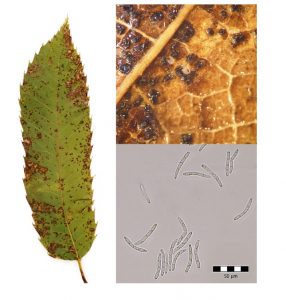 | Pažitný, J; Kobza, M; Adamčíková, K Variance in leaf spot susceptibility in chestnut trees of different species and hybrids Journal Article Journal of Plant Disease and Protection, 126 (2), pp. 169-172, 2019, ISSN: 1861-3829. @article{Pažitný2019, title = {Variance in leaf spot susceptibility in chestnut trees of different species and hybrids}, author = {J. Pažitný and M. Kobza and K. Adamčíková}, url = {https://link.springer.com/article/10.1007/s41348-019-00209-9}, doi = {DOI 10.1007/s41348-019-00209-9}, issn = {1861-3829}, year = {2019}, date = {2019-02-19}, journal = {Journal of Plant Disease and Protection}, volume = {126}, number = {2}, pages = {169-172}, abstract = {Prior to the first occurrence of chestnut blight in 1976, leaf spot caused by Cylindrosporium castaneae was one of the most important diseases of European chestnut trees in Slovakia. In 2011, extensive damage of leaves by leaf spot was recorded in young chestnut trees in an experimental chestnut orchard in Pribelce, Slovakia, where seedlings and grafts of different taxonomic origin (Castanea sativa, Castanea crenata, and C. sativa × C. crenata) exhibited visible differences in the extent of leaf spot. Digital images of particular leaves were evaluated using Quick Micro Photo software and the ratio of infected leaf area was calculated. Morphological observations of the fungal species causing leaf spot were conducted and the disease symptoms were described and discussed. Taxonomic origin of studied trees showed a significant effect on the proportion of leaf spot area, indicating that the response to fungal attacks has a strong genetic determinism, with resistance being clearly influenced by taxonomic origin. The lowest leaf spot infection was recorded in C. crenata seedlings. Significant differences were noted between the individual trees tested and between the studied years.}, keywords = {}, pubstate = {published}, tppubtype = {article} } Prior to the first occurrence of chestnut blight in 1976, leaf spot caused by Cylindrosporium castaneae was one of the most important diseases of European chestnut trees in Slovakia. In 2011, extensive damage of leaves by leaf spot was recorded in young chestnut trees in an experimental chestnut orchard in Pribelce, Slovakia, where seedlings and grafts of different taxonomic origin (Castanea sativa, Castanea crenata, and C. sativa × C. crenata) exhibited visible differences in the extent of leaf spot. Digital images of particular leaves were evaluated using Quick Micro Photo software and the ratio of infected leaf area was calculated. Morphological observations of the fungal species causing leaf spot were conducted and the disease symptoms were described and discussed. Taxonomic origin of studied trees showed a significant effect on the proportion of leaf spot area, indicating that the response to fungal attacks has a strong genetic determinism, with resistance being clearly influenced by taxonomic origin. The lowest leaf spot infection was recorded in C. crenata seedlings. Significant differences were noted between the individual trees tested and between the studied years. |
2018 |
|
 | Jánošíková-Hečková, Z; Ondrušková, E; Barta, M; Ostrovský, R; Kádasi-Horáková, M; Pastirčáková, K; Kobza, M; Adamčíková, K The hosts and geographic range of Dothistroma needle blight in Slovakia Journal Article Forest Pathology, 48 (3), pp. e12421, 2018, ISSN: 1437-4781. @article{Jánošíková-Hečková2018, title = {The hosts and geographic range of Dothistroma needle blight in Slovakia}, author = {Z. Jánošíková-Hečková and E. Ondrušková and M. Barta and R. Ostrovský and M. Kádasi-Horáková and K. Pastirčáková and M. Kobza and K. Adamčíková }, url = {https://onlinelibrary.wiley.com/doi/abs/10.1111/efp.12421}, doi = {10.1111/efp.12421}, issn = {1437-4781}, year = {2018}, date = {2018-02-15}, journal = {Forest Pathology}, volume = {48}, number = {3}, pages = {e12421}, abstract = {The occurrence and distribution of Dothistroma needle blight (DNB) were studied in 2014–2017 around Slovakia. A total of 84 localities, both native and planted, were investigated, and the presence of DNB was confirmed in 73 of them. In all positive locations, symptoms typical of DNB were observed and the Dothistroma species was confirmed using species-specific primers either from fungal cultures or directly from needles. Both Dothistroma species—D. septosporum and D. pini—were identified. Both species occurred together in 29 locations, only D. septosporum in 42 and only D. pini in two locations. The host range of D. septosporum included 10 pine species and two spruce species. The host range of D. pini comprised the same number of pine hosts but only one spruce species. Five pine hosts, P. aristata, P. coulteri, P. densiflora, P. jeffreyi, P. × schwerinii, and one spruce host P. abies are new hosts species of D. pini. P. densiflora and Picea pungens have earlier been reported to be susceptible for DNB. In this study, D. septosporum was found from both tree species.}, keywords = {}, pubstate = {published}, tppubtype = {article} } The occurrence and distribution of Dothistroma needle blight (DNB) were studied in 2014–2017 around Slovakia. A total of 84 localities, both native and planted, were investigated, and the presence of DNB was confirmed in 73 of them. In all positive locations, symptoms typical of DNB were observed and the Dothistroma species was confirmed using species-specific primers either from fungal cultures or directly from needles. Both Dothistroma species—D. septosporum and D. pini—were identified. Both species occurred together in 29 locations, only D. septosporum in 42 and only D. pini in two locations. The host range of D. septosporum included 10 pine species and two spruce species. The host range of D. pini comprised the same number of pine hosts but only one spruce species. Five pine hosts, P. aristata, P. coulteri, P. densiflora, P. jeffreyi, P. × schwerinii, and one spruce host P. abies are new hosts species of D. pini. P. densiflora and Picea pungens have earlier been reported to be susceptible for DNB. In this study, D. septosporum was found from both tree species. |
2017 |
|
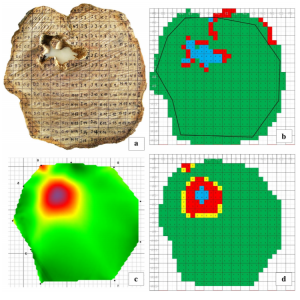 | Ostrovský, R; Kobza, M; Gažo, J Extensively damaged trees tested with acoustic tomography considering tree stability in urban greenery Journal Article Trees Structure and Function, 31 (3), pp. 1015-1023, 2017, ISSN: 1432-2285. @article{Ostrovský2017, title = {Extensively damaged trees tested with acoustic tomography considering tree stability in urban greenery}, author = {R. Ostrovský and M. Kobza and J. Gažo}, url = {https://link.springer.com/article/10.1007%2Fs00468-017-1526-6}, doi = {10.1007/s00468-017-1526-6}, issn = {1432-2285}, year = {2017}, date = {2017-02-07}, journal = {Trees Structure and Function}, volume = {31}, number = {3}, pages = {1015-1023}, abstract = {Objectives of study were to assess the accuracy and reliability of the acoustic tomography technique for detecting internal structural defects compared to visual assessment on extensively damaged trees of five species in urban greenery. Tomography was realized by Fakopp 3D acoustic tomograph tool. Several types of structural defects were determined, such as heartwood and sapwood decay, internal and lateral cracks, ring shake and hollow. Acoustic tomography inspection revealed correct detection of damage in all disc samples involved in study. Accuracy of damaged area determination reached 90%. Total accuracy determination for both area and location of damage was 83%. Overestimation of damaged area was observed in eight samples, contrary to seven underestimated samples. Difference in estimated false-positive area in comparison to false-negative area was minimal. Irregularity of cross section shape does not affect the final accuracy of tomograph. Accuracy is not influenced by diameter of tree trunk. We determined strong positive correlation between real area of damage and results of tomography (r = 0.75; p = 0.001). Acoustic tomography provides satisfactory accuracy in damage area determination inside tree trunk and for overall tree stability assessment on even extensively damaged trees in urban greenery.}, keywords = {}, pubstate = {published}, tppubtype = {article} } Objectives of study were to assess the accuracy and reliability of the acoustic tomography technique for detecting internal structural defects compared to visual assessment on extensively damaged trees of five species in urban greenery. Tomography was realized by Fakopp 3D acoustic tomograph tool. Several types of structural defects were determined, such as heartwood and sapwood decay, internal and lateral cracks, ring shake and hollow. Acoustic tomography inspection revealed correct detection of damage in all disc samples involved in study. Accuracy of damaged area determination reached 90%. Total accuracy determination for both area and location of damage was 83%. Overestimation of damaged area was observed in eight samples, contrary to seven underestimated samples. Difference in estimated false-positive area in comparison to false-negative area was minimal. Irregularity of cross section shape does not affect the final accuracy of tomograph. Accuracy is not influenced by diameter of tree trunk. We determined strong positive correlation between real area of damage and results of tomography (r = 0.75; p = 0.001). Acoustic tomography provides satisfactory accuracy in damage area determination inside tree trunk and for overall tree stability assessment on even extensively damaged trees in urban greenery. |
2015 |
|
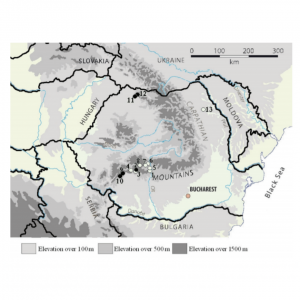 | Adamčíková, K; Ondrušková, E; Kádasi-Horáková, M; Botu, M; Kobza, M; Achim, G Distribution and population structure of the chestnut blight fungus in Romania Journal Article Plant Protection Science, 51 (3), pp. 141-149, 2015. @article{Adamčíková2015, title = {Distribution and population structure of the chestnut blight fungus in Romania}, author = {K. Adamčíková and E. Ondrušková and M. Kádasi-Horáková and M. Botu and M. Kobza and G. Achim}, url = {http://www.agriculturejournals.cz/publicFiles/157004.pdf}, doi = {10.17221/52/2014-PPS}, year = {2015}, date = {2015-01-01}, journal = {Plant Protection Science}, volume = {51}, number = {3}, pages = {141-149}, abstract = {The occurrence of chestnut blight (Cryphonectria parasitica) was studied in 2011-2012 at 13 locations in the main chestnut growing areas of Romania. Infections were detected at four localities. The symptoms and the fungus were detected on European chestnut (four localities) and also on oak trees (two localities). A total of 89 isolates of C. parasitica were isolated and characterised. Based on canker and isolate morphology (culture morphology and the Bavendamm test), both virulent and hypovirulent samples were isolated; hypovirulent isolates were found at only one locality. Two vegetative compatibility types corresponding to EU-12 and EU-2 were identified among isolates. Both mating types were found, with a dominance of MAT-1 in southern Romania and MAT-2 in northern Romania.}, keywords = {}, pubstate = {published}, tppubtype = {article} } The occurrence of chestnut blight (Cryphonectria parasitica) was studied in 2011-2012 at 13 locations in the main chestnut growing areas of Romania. Infections were detected at four localities. The symptoms and the fungus were detected on European chestnut (four localities) and also on oak trees (two localities). A total of 89 isolates of C. parasitica were isolated and characterised. Based on canker and isolate morphology (culture morphology and the Bavendamm test), both virulent and hypovirulent samples were isolated; hypovirulent isolates were found at only one locality. Two vegetative compatibility types corresponding to EU-12 and EU-2 were identified among isolates. Both mating types were found, with a dominance of MAT-1 in southern Romania and MAT-2 in northern Romania. |
![Škodcovia gaštana jedlého [Pests of European chestnut]](http://ife.sk/wp-content/uploads/2016/10/Img-1-206x300.jpg) | Kobza, M; Ostrovský, R Škodcovia gaštana jedlého [Pests of European chestnut] Book Chapter Cagáň, Ľ (Ed.): Choroby a škodcovia záhradníckych rastlín, pp. 301-307, SPU v Nitre, Nitra, 1, 2015, ISBN: 978-80-552-1448-1. @inbook{Kobza2015, title = {Škodcovia gaštana jedlého [Pests of European chestnut]}, author = {M. Kobza and R. Ostrovský}, editor = {Ľ. Cagáň}, isbn = {978-80-552-1448-1}, year = {2015}, date = {2015-01-01}, booktitle = {Choroby a škodcovia záhradníckych rastlín}, pages = {301-307}, publisher = {SPU v Nitre}, address = {Nitra}, edition = {1}, keywords = {}, pubstate = {published}, tppubtype = {inbook} } |
Kobza, M; Ostrovský, R Škodcovia orecha kráľovského [Pest of walnut] Book Chapter Cagáň, Ľ (Ed.): Choroby a škodcovia záhradníckych rastlín, pp. 293-299, SPU v Nitre, Nitra, 1, 2015, ISBN: 978-80-552-1448-1. @inbook{Kobza2015b, title = {Škodcovia orecha kráľovského [Pest of walnut]}, author = {M. Kobza and R. Ostrovský}, editor = {Ľ. Cagáň}, isbn = {978-80-552-1448-1}, year = {2015}, date = {2015-01-01}, booktitle = {Choroby a škodcovia záhradníckych rastlín}, pages = {293-299}, publisher = {SPU v Nitre}, address = {Nitra}, edition = {1}, keywords = {}, pubstate = {published}, tppubtype = {inbook} } | |
Kobza, M; Ostrovský, R Škodcovia moruší [Pests of mulberries] Book Chapter Cagáň, Ľ (Ed.): Choroby a škodcovia záhradníckych rastlín, pp. 437-445, SPU v Nitre, Nitra, 1, 2015, ISBN: 978-80-552-1448-1. @inbook{Kobza2015b, title = {Škodcovia moruší [Pests of mulberries]}, author = {M. Kobza and R. Ostrovský}, editor = {Ľ. Cagáň}, isbn = {978-80-552-1448-1}, year = {2015}, date = {2015-01-01}, booktitle = {Choroby a škodcovia záhradníckych rastlín}, pages = {437-445}, publisher = {SPU v Nitre}, address = {Nitra}, edition = {1}, keywords = {}, pubstate = {published}, tppubtype = {inbook} } | |
 | Ostrovský, R; Kobza, M Význam starostlivosti o dreviny vo verejnej zeleni Proceeding Ústav ekológie lesa SAV Zvolen, Pobočka biológie drevín Nitra, Nitra, 2015, ISBN: 978-80-89408-19-1. @proceedings{Ostrovský2015, title = {Význam starostlivosti o dreviny vo verejnej zeleni}, author = {R. Ostrovský and M. Kobza}, editor = {P. Hrubík and H. Ivanová}, isbn = {978-80-89408-19-1}, year = {2015}, date = {2015-01-01}, booktitle = {Zborník príspevkov z konferencie s medzinárodnou účasťou, 28. - 29. 4 2015, Nitra [Importance of care of trees in urban area: conference proceedings]}, pages = {159}, publisher = {Ústav ekológie lesa SAV Zvolen, Pobočka biológie drevín Nitra}, address = {Nitra}, keywords = {}, pubstate = {published}, tppubtype = {proceedings} } |
2014 |
|
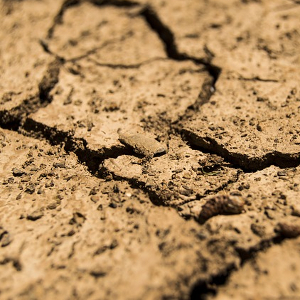 | Balkovič, J; Bedrna, Z; Bublinec, E; Čurlík, J; Dlapa, P; Fulajtár, E; Gömöryová, E; Gregor, J; Hanes, J; Houšková, B; Hutár, V; Chlpík, J; Ilavská, B; Juráni, B; Kobza, B; Kotorková, D; Kukla, J; Kuklová, M; Machava, J; Nádašský, J; Nochta, P; Nováková, K; Orfánus, T; Pavlenda, P; Pichler, V; Pišút, P; Skalský, R; Sobocká, J; Šimanský, V; Tatarková, Z; Tobiášová, E; Zaujec, A; Zverková, M Morphogenetic soil classification system of Slovakia: basal reference taxonomy Book 2nd edition, Societas pedologica slovaca, Bratislava, 2014, ISBN: 978-80-8163-005-7. @book{Balkovič2014, title = {Morphogenetic soil classification system of Slovakia: basal reference taxonomy}, author = {J. Balkovič and Z. Bedrna and E. Bublinec and J. Čurlík and P. Dlapa and E. Fulajtár and E. Gömöryová and J. Gregor and J. Hanes and B. Houšková and V. Hutár and J. Chlpík and B. Ilavská and B. Juráni and B. Kobza and D. Kotorková and J. Kukla and M. Kuklová and J. Machava and J. Nádašský and P. Nochta and K. Nováková and T. Orfánus and P. Pavlenda and V. Pichler and P. Pišút and R. Skalský and J. Sobocká and V. Šimanský and Z. Tatarková and E. Tobiášová and A. Zaujec and M. Zverková}, isbn = {978-80-8163-005-7}, year = {2014}, date = {2014-01-01}, pages = {96}, publisher = {Societas pedologica slovaca}, address = {Bratislava}, edition = {2nd edition}, institution = {Výskumný ústav pôdoznalectva a ochrany pôdy}, keywords = {}, pubstate = {published}, tppubtype = {book} } |
![Príčiny hromadného hynutia gaštana jedlého [Causal agent of European chestnut blight]](https://ife.sk/wp-content/uploads/2016/10/IFE_adamcikova_katarina_article_08.jpg) | Juhásová, G; Adamčíková, K; Kobza, M; Ostrovský, R Príčiny hromadného hynutia gaštana jedlého [Causal agent of European chestnut blight] Journal Article Zahradnictví : časopis profesionálních zahradníků, 13 (7), pp. 48-51, 2014, ISSN: 1213-7596. @article{Juhásová2014, title = {Príčiny hromadného hynutia gaštana jedlého [Causal agent of European chestnut blight]}, author = {G. Juhásová and K. Adamčíková and M. Kobza and R. Ostrovský}, issn = {1213-7596}, year = {2014}, date = {2014-01-01}, journal = {Zahradnictví : časopis profesionálních zahradníků}, volume = {13}, number = {7}, pages = {48-51}, keywords = {}, pubstate = {published}, tppubtype = {article} } |
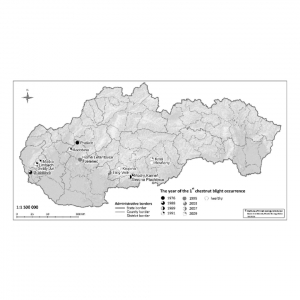 | Bolvanský, M; Ostrovský, R; Kobza, M; Adamčíková, K; Pažitný, J; Juhásová, G; Kajaba, P Spread of chestnut blight in Slovakia in relation to the site topography and climatic characteristics Inproceedings Acta Horticulturae: Proceedings of the second European congress on chestnut : Debrecen, Hungary, Baia Mare, Romania, Modry Kamen, Slovakia, October 9-12, 2013. , pp. 35-42, ISHS, 2014, ISBN: 978 94 6261 032 3. @inproceedings{Bolvanský2014, title = {Spread of chestnut blight in Slovakia in relation to the site topography and climatic characteristics}, author = {M. Bolvanský and R. Ostrovský and M. Kobza and K. Adamčíková and J. Pažitný and G. Juhásová and P. Kajaba}, isbn = {978 94 6261 032 3}, year = {2014}, date = {2014-01-01}, booktitle = {Acta Horticulturae: Proceedings of the second European congress on chestnut : Debrecen, Hungary, Baia Mare, Romania, Modry Kamen, Slovakia, October 9-12, 2013. }, number = {1043}, pages = {35-42}, publisher = {ISHS}, keywords = {}, pubstate = {published}, tppubtype = {inproceedings} } |
![Gaštan jedlý na Slovensku a v Európe : pestovanie, ochrana, variabilita a využitie [European chestnut in Slovakia : growing, protection, use and genetic variability]](http://ife.sk/wp-content/uploads/2016/10/IFE_adamcikova_katarina_article_08.jpg) | Adamčíková, K; Kobza, M; Juhásová, G; Ondrušková, E; Bolvanský, M; Kádasi-Horáková, M Gaštan jedlý na Slovensku a v Európe : pestovanie, ochrana, variabilita a využitie [European chestnut in Slovakia : growing, protection, use and genetic variability] Book Garamond, Nitra, 2014, ISBN: 978-80-89408-18-4. @book{Adamčíková2014, title = {Gaštan jedlý na Slovensku a v Európe : pestovanie, ochrana, variabilita a využitie [European chestnut in Slovakia : growing, protection, use and genetic variability]}, author = {K. Adamčíková and M. Kobza and G. Juhásová and E. Ondrušková and M. Bolvanský and M. Kádasi-Horáková}, isbn = {978-80-89408-18-4}, year = {2014}, date = {2014-01-01}, volume = {1}, pages = {155}, publisher = {Garamond}, address = {Nitra}, keywords = {}, pubstate = {published}, tppubtype = {book} } |
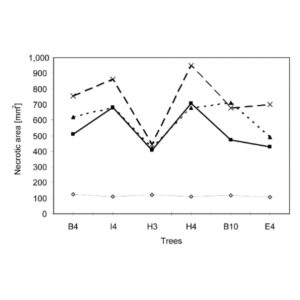 | Bolvanský, M; Adamčíková, K; Kobza, M Screening resistance to chestnut blight in young chestnut trees derived from Castanea sativa × C. crenata hybrids Journal Article Folia Oecologica, 41 (1), pp. 1-7, 2014, ISSN: 1336-5266. @article{Bolvanský2014c, title = {Screening resistance to chestnut blight in young chestnut trees derived from \textit{Castanea sativa} × \textit{C. crenata} hybrids}, author = {M. Bolvanský and K. Adamčíková and M. Kobza}, url = {http://ife.sk/wp-content/uploads/2016/10/FO_v41_iss1_1to7.pdf}, issn = {1336-5266}, year = {2014}, date = {2014-01-01}, journal = {Folia Oecologica}, volume = {41}, number = {1}, pages = {1-7}, abstract = {In 2010, 2011 and 2012 four trials were carried out to prove a reliability of the new screening method for resistance to chestnut blight caused by Cryphonectria parasitica. In the selected trees of hybrid origin (C. sativa × C. crenata)) 10 cm long cut-branch sections were inoculated with mycelia of three virulent isolates and one hypovirulent isolate (in two last trials) and cultivated for 7 days in the dark at 25 °C with 95% humidity. Then the bark of branch segments was peeled off and the size of necrotic lesions formed on the wood tissue around the inoculation place was measured. The size of necrotic areas varied by sampling date, type of fungus strains and tested trees. In all three summer trials necrotic lesions were larger than lesions in a spring trial of 2011, in which still dormant stem sections were used. Unlike the summer trials in the spring trial higher differences in the size of necrotic lesions among tested trees and among used virulent strains were observed. In the spring trial interactions between tested trees and fungal isolates were not so frequent like in summer trials where more trees exhibited different response to the same virulent strain. Majority of trees showed different susceptibility in particular trials. Observed high variation of reactions of tested trees to both virulent and hypovirulent isolates has pointed at the need to prove other screening methods, and to find such one, that would be highly effective to reveal an inherited resistance and/or a lower degree of susceptibility to chestnut blight.}, keywords = {}, pubstate = {published}, tppubtype = {article} } In 2010, 2011 and 2012 four trials were carried out to prove a reliability of the new screening method for resistance to chestnut blight caused by Cryphonectria parasitica. In the selected trees of hybrid origin (C. sativa × C. crenata)) 10 cm long cut-branch sections were inoculated with mycelia of three virulent isolates and one hypovirulent isolate (in two last trials) and cultivated for 7 days in the dark at 25 °C with 95% humidity. Then the bark of branch segments was peeled off and the size of necrotic lesions formed on the wood tissue around the inoculation place was measured. The size of necrotic areas varied by sampling date, type of fungus strains and tested trees. In all three summer trials necrotic lesions were larger than lesions in a spring trial of 2011, in which still dormant stem sections were used. Unlike the summer trials in the spring trial higher differences in the size of necrotic lesions among tested trees and among used virulent strains were observed. In the spring trial interactions between tested trees and fungal isolates were not so frequent like in summer trials where more trees exhibited different response to the same virulent strain. Majority of trees showed different susceptibility in particular trials. Observed high variation of reactions of tested trees to both virulent and hypovirulent isolates has pointed at the need to prove other screening methods, and to find such one, that would be highly effective to reveal an inherited resistance and/or a lower degree of susceptibility to chestnut blight. |
2013 |
|
![Diversity of microfungi on branches of Castanea sativa in Slovakia [Diverzita mikroskopických húb na konároch Castanea sativa na Slovensku]](http://ife.sk/wp-content/uploads/2016/10/g4646.png) | Adamčíková, K; Juhásová, G; Kobza, M; Ondrušková, E Diversity of microfungi on branches of Castanea sativa in Slovakia [Diverzita mikroskopických húb na konároch Castanea sativa na Slovensku] Journal Article Polish Botanical Journal, 58 (2), pp. 741-746, 2013, ISSN: 1641-8180. @article{Adamčíková2013, title = {Diversity of microfungi on branches of Castanea sativa in Slovakia [Diverzita mikroskopických húb na konároch Castanea sativa na Slovensku]}, author = {K. Adamčíková and G. Juhásová and M. Kobza and E. Ondrušková}, issn = {1641-8180}, year = {2013}, date = {2013-01-01}, journal = {Polish Botanical Journal}, volume = {58}, number = {2}, pages = {741-746}, abstract = {Localities in Castanea sativa Mill. plantations were visited in a study aimed at identifying the mycoflora of C. sativa in Slovakia [excluding Cryphonectria parasitica (Murr.), Barr for which much data is available]. Samples from chestnut tree branches and stems were examined visually and microscopically. Seven species of microfungi were recorded, three with their anamorphs. Coryneum modonium (Sacc.) Griffon & Maubl. and Phomopsis castaneae Woron. were the most common. Libertella quercina Tul. & C. Tul. was identified in both states (anamorph and teleomorph) at two new localities. The records of Gloniopsis praelonga (Schwein.) Underw. & Earle and Dothidotthia celtidis (Ellis & Everh.) M. E. Barr are the first for Slovakia. These species were rare, found only in one locality. Two microscopic fungi were detected: Valsa ambiens (Pers.) Fr. [Cytospora leucosperma (Pers.) Fr.] and Diplodina castaneae Prill. & Delacr.}, keywords = {}, pubstate = {published}, tppubtype = {article} } Localities in Castanea sativa Mill. plantations were visited in a study aimed at identifying the mycoflora of C. sativa in Slovakia [excluding Cryphonectria parasitica (Murr.), Barr for which much data is available]. Samples from chestnut tree branches and stems were examined visually and microscopically. Seven species of microfungi were recorded, three with their anamorphs. Coryneum modonium (Sacc.) Griffon & Maubl. and Phomopsis castaneae Woron. were the most common. Libertella quercina Tul. & C. Tul. was identified in both states (anamorph and teleomorph) at two new localities. The records of Gloniopsis praelonga (Schwein.) Underw. & Earle and Dothidotthia celtidis (Ellis & Everh.) M. E. Barr are the first for Slovakia. These species were rare, found only in one locality. Two microscopic fungi were detected: Valsa ambiens (Pers.) Fr. [Cytospora leucosperma (Pers.) Fr.] and Diplodina castaneae Prill. & Delacr. |
2012 |
|
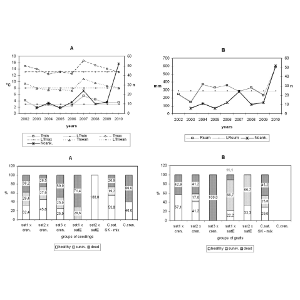 | Adamčíková, K; Kobza, M; Bolvanský, M; Ondrušková, E Spread and population structure of Cryphonectria parasitica in a young chestnut orchard in Slovakia Journal Article Central European Journal of Biology, 7 (2), pp. 267–274, 2012. @article{K.2012, title = {Spread and population structure of \textit{Cryphonectria parasitica} in a young chestnut orchard in Slovakia}, author = {K. Adamčíková and M. Kobza and M. Bolvanský and E. Ondrušková}, url = {http://link.springer.com/article/10.2478/s11535-012-0009-4}, year = {2012}, date = {2012-02-10}, journal = {Central European Journal of Biology}, volume = {7}, number = {2}, pages = {267–274}, abstract = {The chestnut blight pathogen Cryphonectria parasitica was studied in a chestnut collection composed of both seedlings and grafts derived from selected Castanea sativa and C. sativa x C. crenata trees located in south-east Slovakia, near village Príbelce on an area of approximately 3.5 ha. The study was conducted during eight years (2003-2010). During this period 133 trees were infected, which represents 59.82% of chestnut trees of all chestnut accessions. Based on the phenotype of the fungus culture and the type of cankers in the field, all isolates were determined to be virulent. No hypovirulent strains were found. No vegetative compatibility (vc) type diversity was observed. More than 130 isolates were analyzed for vc and all were in single vc type, which was identical with EU 12. All isolates assayed for mating type were MAT-1. No perithecia were observed. No significant differences were found between the proportion of cankered and dead cankered trees in seedlings and grafts of hybrid origin (C. sativa x C. crenata) and of C. sativa origin. However, particular seedlings and grafts of hybrid origin seemed to exhibit certain resistance to chestnut blight.}, keywords = {}, pubstate = {published}, tppubtype = {article} } The chestnut blight pathogen Cryphonectria parasitica was studied in a chestnut collection composed of both seedlings and grafts derived from selected Castanea sativa and C. sativa x C. crenata trees located in south-east Slovakia, near village Príbelce on an area of approximately 3.5 ha. The study was conducted during eight years (2003-2010). During this period 133 trees were infected, which represents 59.82% of chestnut trees of all chestnut accessions. Based on the phenotype of the fungus culture and the type of cankers in the field, all isolates were determined to be virulent. No hypovirulent strains were found. No vegetative compatibility (vc) type diversity was observed. More than 130 isolates were analyzed for vc and all were in single vc type, which was identical with EU 12. All isolates assayed for mating type were MAT-1. No perithecia were observed. No significant differences were found between the proportion of cankered and dead cankered trees in seedlings and grafts of hybrid origin (C. sativa x C. crenata) and of C. sativa origin. However, particular seedlings and grafts of hybrid origin seemed to exhibit certain resistance to chestnut blight. |
 | Juhásová, G; Adamčíková, K; Bolvanský, M; Ivanová, H; Tokár, F; Hrubík, P; Konôpková, J; Kobza, M; Ondrušková, M; Kollár, J; Kunová, A Gaštan jedlý na Slovensku. Perspektívy jeho ochrany a pestovania. Book Garmond, Nitra, 2012, ISBN: 978-80-89408-14-6 1. @book{Juhásová2012, title = {Gaštan jedlý na Slovensku. Perspektívy jeho ochrany a pestovania.}, author = {G. Juhásová and K. Adamčíková and M. Bolvanský and H. Ivanová and F. Tokár and P. Hrubík and J. Konôpková and M. Kobza and M. Ondrušková and J. Kollár and A. Kunová}, isbn = {978-80-89408-14-6 1}, year = {2012}, date = {2012-01-01}, pages = {156}, publisher = {Garmond}, address = {Nitra}, keywords = {}, pubstate = {published}, tppubtype = {book} } |
2009 |
|
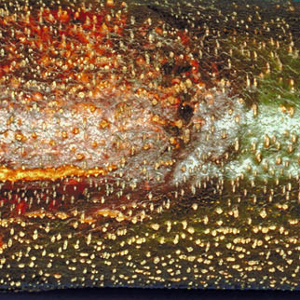 | Adamčíková, K; Kobza, M; Juhasová, G Horticultural Science , 36 (2), pp. 55-60, 2009. @article{Adamcikova2009, title = { The development of population structure of Cryphonectria parasitica on European chestnut (Castanea sativa Mill.) in the Experimental Castanetarium Horne Lefantovce, observed over a 12-year study period}, author = {K. Adamčíková and M. Kobza and G. Juhasová}, url = {http://www.agriculturejournals.cz/publishedArticles/HORTSCI/2009-36-2-55.pdf}, year = {2009}, date = {2009-01-01}, journal = {Horticultural Science }, volume = {36}, number = {2}, pages = {55-60}, abstract = {We studied occurrence of chestnut blight disease in the Experimental Castanetarium Horne Lefantovce, SW Slovakia. The study ran in years 2006-2007 on a set consisting of 889 chestnut trees growing in the clonal orchard on Biological Plot 105. From this number, 857 trees were found healthy without disease symptoms. The chestnut blight disease was identified on 32 of them. The infected trees were examined for presence of pycnidia and perithecia of the causal agent. In all positive cases, the observed morphological characters indicated virulency of the obtained isolates. No hypovirulent isolate was detected on the evaluated experimental plot. In total, six vegetative compatibility (vc) types were specified in the sample consisting of 31 isolates. Our vc types corresponded to the European vc types EU 2, EU 12, EU 13, EU 14, EU 17, EU 19. Two vc types - EU 2 and EU 19 - were dominant. Vc type EU 19 accounted 35.5% and EU 2 32.2% of isolates. The vc type EU 19, which was the most frequent one in the evaluated site, was detected in Slovakia for the first time.}, keywords = {}, pubstate = {published}, tppubtype = {article} } We studied occurrence of chestnut blight disease in the Experimental Castanetarium Horne Lefantovce, SW Slovakia. The study ran in years 2006-2007 on a set consisting of 889 chestnut trees growing in the clonal orchard on Biological Plot 105. From this number, 857 trees were found healthy without disease symptoms. The chestnut blight disease was identified on 32 of them. The infected trees were examined for presence of pycnidia and perithecia of the causal agent. In all positive cases, the observed morphological characters indicated virulency of the obtained isolates. No hypovirulent isolate was detected on the evaluated experimental plot. In total, six vegetative compatibility (vc) types were specified in the sample consisting of 31 isolates. Our vc types corresponded to the European vc types EU 2, EU 12, EU 13, EU 14, EU 17, EU 19. Two vc types - EU 2 and EU 19 - were dominant. Vc type EU 19 accounted 35.5% and EU 2 32.2% of isolates. The vc type EU 19, which was the most frequent one in the evaluated site, was detected in Slovakia for the first time. |
